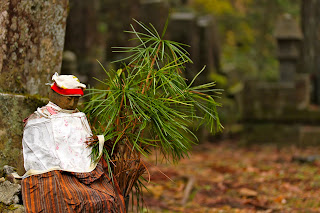I, like everyone else around the world, have been glued to the screen watching the news coverage in Japan. And like everyone else, I just don't know how to put into words how I feel about the whole tragedy, and can't even begin to imagine how those remaining in Tohoku feel. Their homes, family and friends - their lives - wiped out in an instant, and continue to live in fear of aftershocks on top of a nuclear situation. My heart really goes out to them. It's sad to think that one of the last places I visited in Japan before returning to Australia probably won't ever be the same.
Stepping off the
shinkansen in one hot summer day in August last year, I had no idea what to expect from Sendai. Essentially, it was just a town that up north that I felt I should see; What exactly it was that I was supposed to see there, I had no idea. But travel fatigue had set in, and I was tired of moving from place to place every day. So rather than spending a day in Sendai and another in nearby Niigata, I booked a hotel for two days and hoped I would find stuff to keep me occupied for the time.

Although I had heard of this 'Tanabata festival' that was pretty huge there, I pretty much just ignored all information about it, thinking it wasn't really relevant to me. After all, Tanabata is celebrated all around Japan, it from my previous experience, it just involves people tying their handwritten wishes to a bamboo tree, and eating star-shaped jelly for school lunch. Plus, in Gifu it's celebrated in July, so I thought my chance to see a larger festival with more bamboo and star-shaped foods was over.
As I walked around the station and saw the giant paper lanterns adorning everything, however, it slowly dawned on me that I maybe should have read up on the Tanabata festival a little more. Maybe the people of Sendai
weren't just being lazy and hadn't neglected to take down their month-old decorations.
Being in a town that was known for its festival, it's needless to say that it was pretty packed. But as an avid Japanese festival fan, I couldn't really complain. With the crowds of people came fireworks, performances, a cheerful atmosphere, and of course, stalls upon stalls of festival food.
It was a weird sense of denouement going to my last festival in Japan, and seeing how much had changed since the first festival I went to during my first week in Gifu. Rather than wanting to try every single food offered at the food stalls, I avoided the often-questionable beef skewers and made a beeline straight for the
jaga butter and
takoyaki. The novelty of seeing people wearing
yukatas had worn off so much that I barely batted an eyelid seeing young guys rocking a yukata with orange crocs and anime hair.
Festival celebrations aside, there was more than enough things to fill my time. Initially it does feel like most other towns in Japan, but walking through the city, you notice the history of the area reflected in everything you see. The town is famous for being established by Date Masamune, who, according to my
academic research, is a famous eyepatch-doting samurai that wields up to six swords at once and speaks in a mix of Japanese and English. Okay, so maybe the creators of anime may have exercised their artistic licence on the part, but still, his impact can still be felt in Sendai. Crescent-shaped designs - an homage to Masamune's famous helmet - is incorporated into architecture, street signs, and street lamps throughout the city.
Maybe it's the stories that Masamune was also gourmand that made food a focus there, or maybe it was the food that influenced his decision to relocate there. Either way, it's a city that takes its cuisine very seriously - it's said to be the origin of quite a few different foods, like
zunda mochi,
hiyashi chuka, and most famously,
gyutan. Gyutan is itself is ox tongue that is lightly seasoned, sliced, and grilled, which has become a delicacy all over Japan. It's said to have originated in Sendai after WWII - Occupation forces stationed there often threw away the tail and the tongue, so one restaurant owner decided to use this cheap cut of beef at his restaurant. The restaurant became popular, and now, it's seen in just about every yakiniku restaurant in Japan.
I like the idea of Sendai and
gyutan; It shows the people's resilience in tough times, the ability to make the most of what they have, and prosper. Let's hope the spirit of
gyutan in Sendai, Tohoku, and the rest of Japan still lives on.












